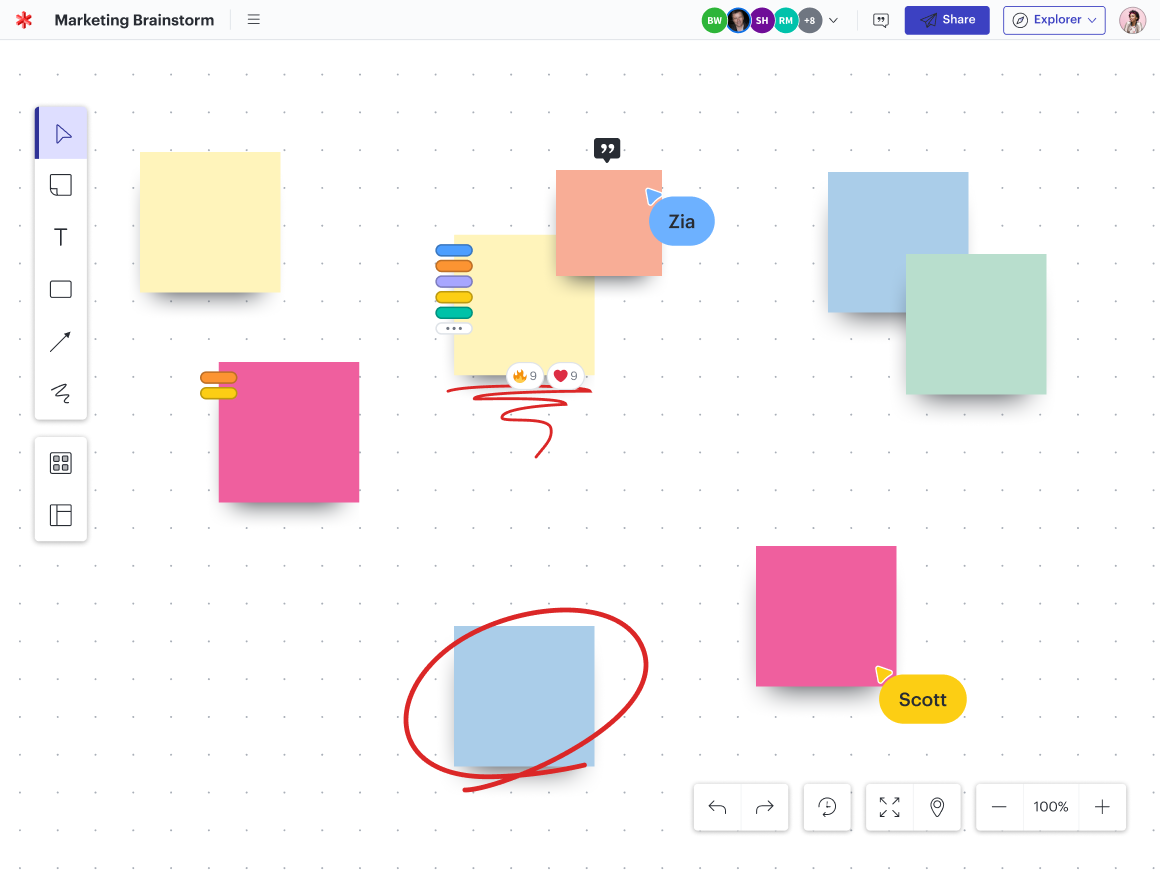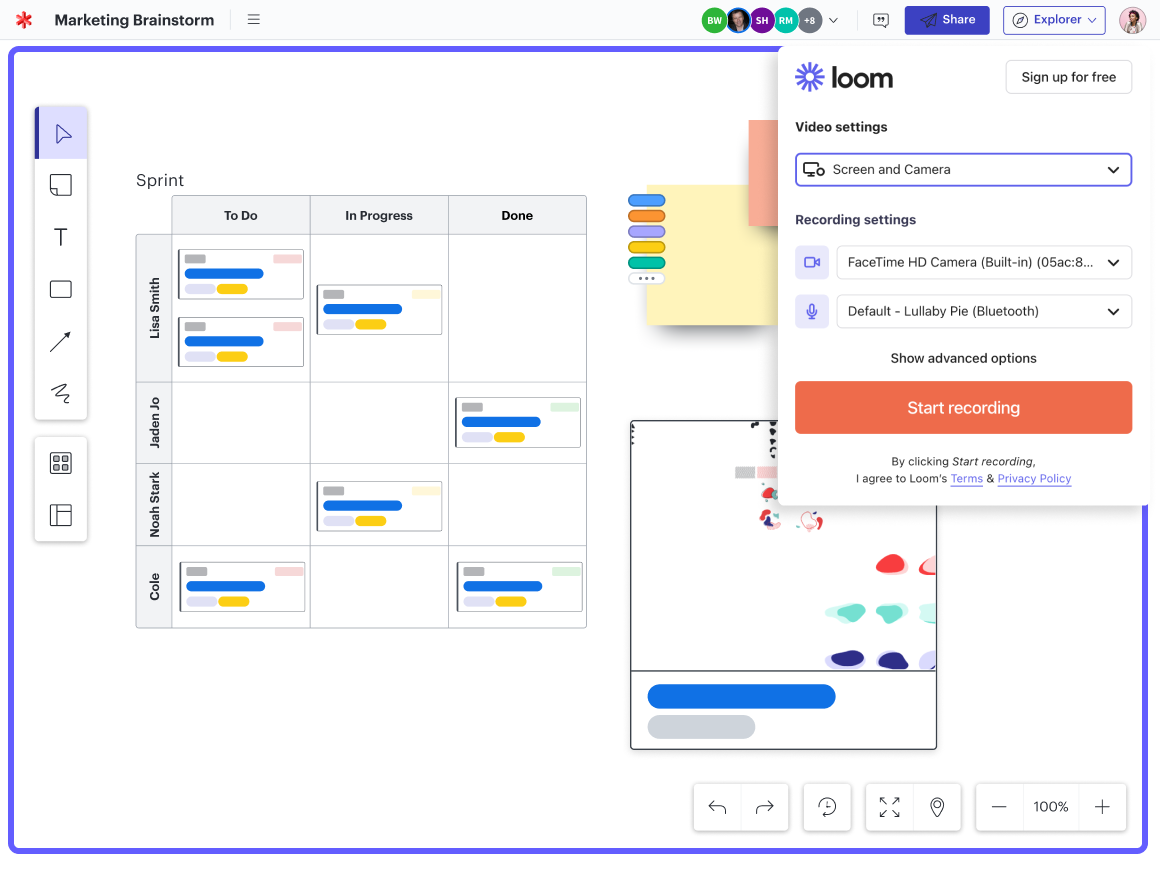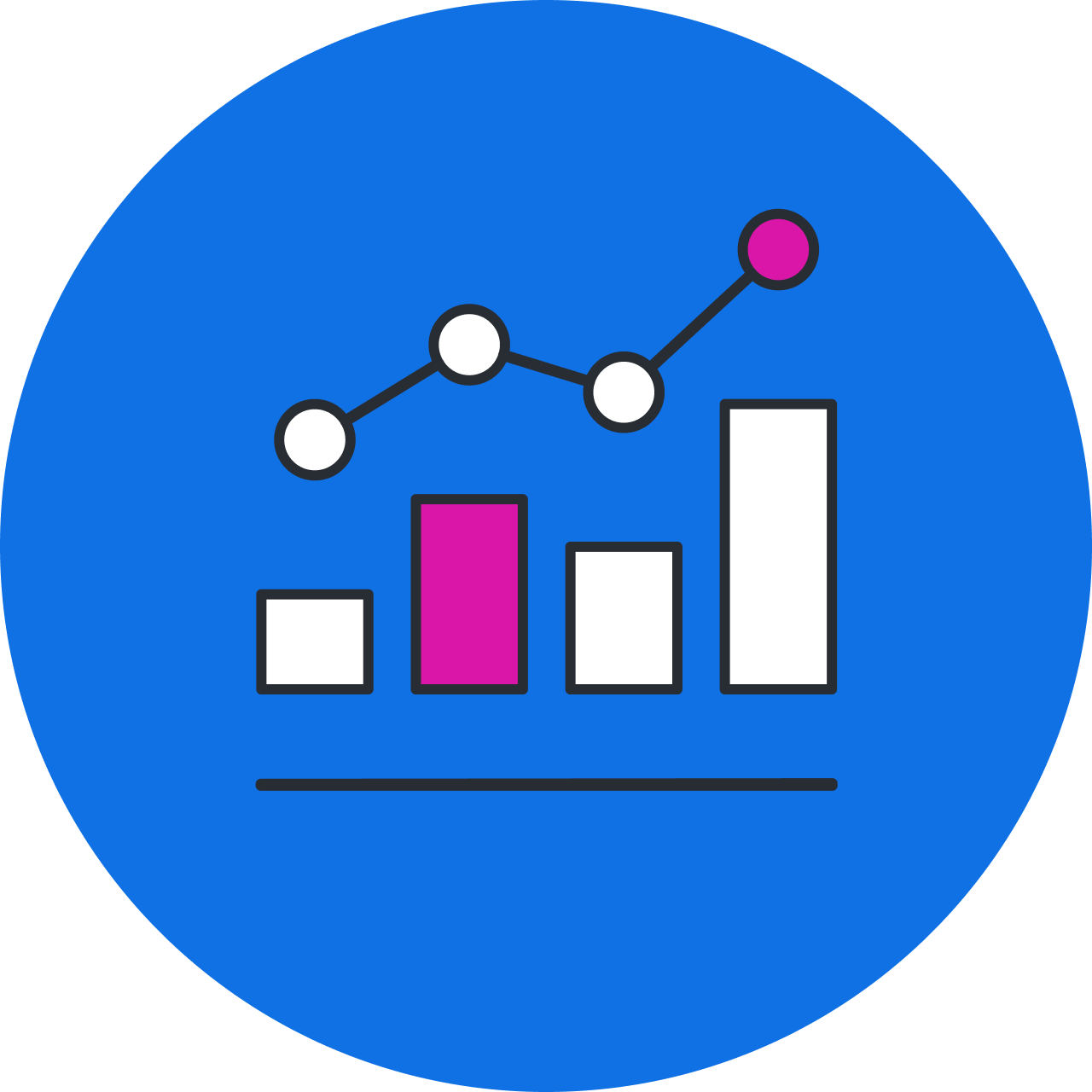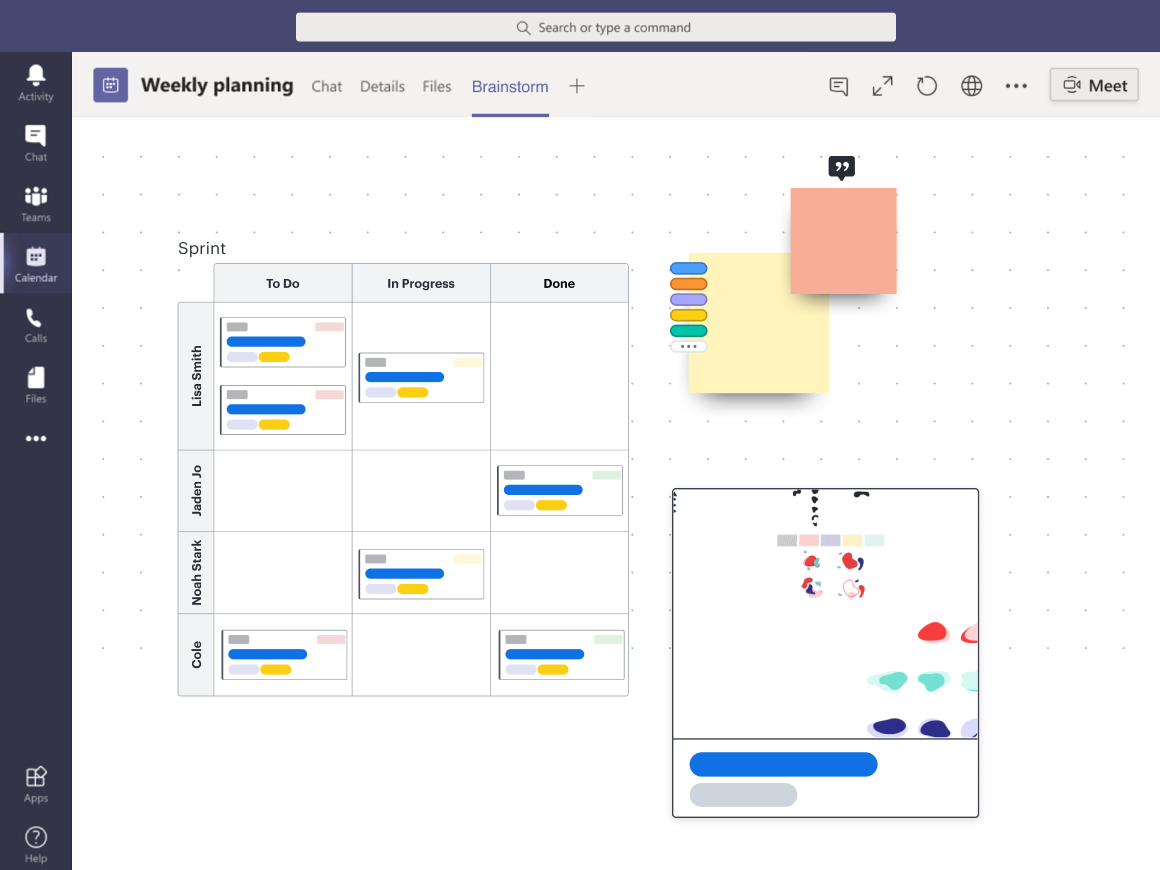
Turning collaborative activities into documentation
Reading time: about 10 min
Topics:
So much of the collaborative work teams do on a daily basis goes untouched after a project launches and the team moves on to a new initiative, never to be revisited again.
This work not only includes unexplored product ideas that could have business value, but also process improvement discoveries, learned best practices, and information that can serve as a valuable historical record.
When organizations don’t invest in maintaining innovation repositories, they don’t know how to unearth this goldmine of usable documentation hidden in all of the artifacts they leave behind after a project. This then causes teams to:
- Spin their wheels starting from scratch instead of building off of something that already exists
- Duplicate work already done by another team
- Retread old ground on ideas that have already proven ineffective for the business
- Waste a lot of time and money on ideas that don’t have resources or support
With a visual collaboration platform like Lucid, teams can easily maintain a living blueprint of their business. And by housing documentation on a visual platform instead of purely text documents and spreadsheets, teams are able to share context quickly with cross-functional teams, bring new employees up to speed faster, and prevent critical information from being stuck in silos.
So how can you convert the important collaborative work your team is doing into valuable, visual documentation you can reference forever?
Five steps for turning collaboration into documentation
Documentation doesn’t have to be a separate task you only complete once a project is over, and it isn’t only for technical processes. Anything worth remembering, repeating, referencing, or revisiting (from a brainstorm or other collaborative planning or working session) can be considered documentation.
Here are some steps you can take to make sure you’re capturing your best work, ideas, processes, and practices so you can continue to draw value from them.
1. Host a collaborative session on a visual canvas
Using a visual canvas is often enough to make organic ad hoc documentation that is easy to understand and pick back up later—even before getting into any clean-up work or integrating other data sources.
Working in an engaging visual space (versus simply talking over video chat or sharing a dense written document) makes it easier for team members to collaborate because:
- Team members are able to give more thorough input by dropping sticky notes and participating in voting sessions and provide reactions to others’ ideas without having to verbally speak up.
- More voices are heard in the collaboration process because the barrier to entry to participate (which is typically “being outspoken and opinionated”) is significantly lowered.
- Teams are able to reach consensus quicker by seeing abstract or complex ideas communicated more simply with visual elements, shapes, and connecting lines.

Here are some practices for hosting collaboration on a visual canvas that will enable you to turn your work into useful documentation later:
- Have at least one person assigned to take notes: Keeping notes on collaborative sessions creates a solid foundation to work from; you can’t document what you don’t remember! Assign or ask someone to take notes to stay on top of this, and encourage your team to err on the side of leaving too many sticky notes on your board so you can make sure every idea thread is accounted for.
- Take additional notes on the meta conversation that happens as your team debates and deliberates and converges around ideas: Having a record of how you came to certain decisions is as important as having a record of your ideas. For example, if your team made a strategic 180 in the middle of a brainstorm, consider taking note of that so it can serve as a documentation of your thinking “before” and “after” the breakthrough.
If you’re continuing a brainstorming session you started on a previous day, you might leave some quick notes providing context to new participants.
- Gather quick gut reactions first, then deep feedback later: Use features like comments, emoji reactions, and voting sessions without having to put in too much effort—you can always dig into why people reacted and responded the way they did afterward, but this helps you gauge a direction to take your discussion.
Once you have an initial direction or have outlined key areas of existing consensus, you can focus your deeper discussion on resolving areas of misalignment.
- Use a template to save time: Lucid has templates for any type of collaboration session you might be involved in, from roadmaps for product and sprint planning, brainstorming frameworks to clarify your thinking, or flowchart templates for identifying roadblocks and opportunities for improvement. Adding a template provides a common ground for participation and familiar visual “language” for those that have used that template before.
2. Pull in other additional knowledge resources to your primary boards
Not all the work and planning we do is necessarily going to happen in the visual collaboration space. You might need a spreadsheet for a dense dataset, a dedicated project management tool to ensure you’re meeting deadlines, a rich Google Doc for comprehensive brand guidelines, or you want to add additional context with asynchronous video recordings.

But even if you’re using a large tech stack, you can still manage the collaboration that happens between these discrete sources of information by using a visual canvas as a hub for all of your work. By doing so, all your individual pieces of documentation form a comprehensive living blueprint of your business.
Here’s how to accomplish this:
- Establish dedicated team boards for all of your recurring meetings or cross-functional teams: Make sure you have a reliable space where you’re meeting every time and recording new notes and ideation work. Creating a new board every time for your most foundational meetings (like daily standups or large team meetings) means context is regularly getting lost, and you’re just adding to your clutter of documentation. You can even include your dedicated team board in your meeting invite and agenda so people never have to hunt it down.
- Supplement your brainstorming documentation with other knowledge sources using Lucid integrations: Use rich internal embeds and powerful integrations to provide self-contained context to any board, making it so anyone who visits your dedicated project, team, or meeting board will have all the documentation without needing to hunt down anything else.
For example, you might start out doing user research planning in your Lucid board, add a Loom recording to provide deeper context from an interview to help you explain certain insights, and then bring Asana cards right into your Lucid boards to start planning out and assigning tasks.
Lucid’s thoughtfully designed integration ecosystem makes it easy to build single sources of truth you’ll actually revisit regularly.

Tip: Use Lucid internal embed integrations with apps like Figma, Google Sheets, and CloudApp to create rich documentation.
Try it out3. Evaluate your working documents regularly
Hosting your collaborative sessions on a visual canvas allows you to keep a simple and easy historical record of ideas you have brought to life. But if you want to turn your brainstorms and collaborative artifacts into documented best practices you can follow for future projects, you’ll need to identify which insights and information are worth codifying.
Find time to have a meta-evaluation of the places and documents where you’re doing most of your work, and reflect on what parts of them might be worth formalizing into a process or template for future work. (An easy time to do this is during your project postmortem or retrospective.) You might ask questions like:
- Are there any ideas in this board that we want to explore for future projects?
- Did the process work and have a successful outcome? If so, why do we think it worked so well?
- Was there anything about this process that was worth repeating or anything that we should never repeat?
- Would other teams benefit from following a similar process?
- Is this something we can templatize by turning into a piece of documentation, and would we or others actually use that documentation?
You can hold these retrospectives in the same board that you’re evaluating, so you don’t have to go off memory and can tangibly reference your past work.
4. Clean up, clean up
Once you’ve evaluated what’s worth turning into formal documentation, you can start to turn your collaborative working documents into a framework you can follow for the future.
- Clean up any irrelevant information: While it’s worth keeping old brainstorming notes as helpful context (and you might consider making a copy of these notes instead of deleting them), some content on your board might only be relevant to a specific project and not necessary to include as formal documentation. Go through your working documents and look for pieces of process, structures, or frameworks that are worth repurposing and archive the rest.
- Format your documentation into something reusable: Use frames, Dynamic Matrix, and Lucidchart intelligent diagrams to organize your content into a documentation someone can easily follow. These types of features can help you turn messy, bi-directional brainstorming into calendars, flowcharts, kanban boards, or step-by-step processes. And if you used a Lucid template as a framework at the start of your brainstorming, you’ll have a head start!
If you have a stakeholder or client who'd prefer a physical or offline copy of a piece of documentation, you can also export your Lucid board as an image or PDF.
- Use the signals you collected during your brainstorming session to know what to prioritize: If you used emoji reactions or voting sessions as part of your collaborative work, look for visual elements (like sticky notes or mind maps clusters) that have the most positive engagement and upvotes as indicators of what’s worth keeping as documentation or revisiting for the future.

If you’re finding your documentation too complex to contain on a single board without getting overwhelmed, use Breakout Boards to keep track of sub-processes individually all under the same main board. For example, you could have a main board for a new product release, but keep customer research notes, UX wireframes, and launch calendars all on their own Breakout Boards.
You can also use team folders to keep all of your most referenced documentation in one place.
5. Share your documentation as a living blueprint
Once you’ve turned your collaborative working sessions into functional documentation that’s been organized and combined with other important knowledge bases, it’s time to surface it to all of the places where work gets done in your organization.

One of the easiest ways to do this is to use Lucid’s external embed integrations. These integrations allow you to make sure mission-critical information is always available as compelling visual documentation inside your favorite apps like Asana, Jira, Notion, LeanIX, Google Docs, and more.
By providing easy access to documentation to stakeholders in this way, you can eliminate time lost to context-switching and avoid people having to individually chase down information they need.
The future of documentation is visual
If you're tired of dry, dense documentation that takes hours to write and many more hours to maintain, it's time to ditch it. Simply use a virtual collaboration canvas—or any of the places you're already doing your work—to quickly spin up functional documentation that creates itself.

Get Lucid's full guide—plus over a dozen templates—for effortlessly documenting team structure, organization strategy, product planning, and more.
Read nowAbout Lucid
Lucid Software is the leader in visual collaboration and work acceleration, helping teams see and build the future by turning ideas into reality. Its products include the Lucid Visual Collaboration Suite (Lucidchart and Lucidspark) and airfocus. The Lucid Visual Collaboration Suite, combined with powerful accelerators for business agility, cloud, and process transformation, empowers organizations to streamline work, foster alignment, and drive business transformation at scale. airfocus, an AI-powered product management and roadmapping platform, extends these capabilities by helping teams prioritize work, define product strategy, and align execution with business goals. The most used work acceleration platform by the Fortune 500, Lucid's solutions are trusted by more than 100 million users across enterprises worldwide, including Google, GE, and NBC Universal. Lucid partners with leaders such as Google, Atlassian, and Microsoft, and has received numerous awards for its products, growth, and workplace culture.
Related articles
Guide: How to have effective brainstorms every time
Whether it's in person or virtually, brainstorming effectively with your team isn't easy. Read our guidelines on how to have better brainstorming sessions.
Beyond the buzzword: What is visual collaboration?
It’s time we stop treating visual collaboration like a buzzword. Defined properly, it's the key to aligning teams and accelerating innovation.
How to turn your document repository into an innovation repository
Not all document repositories will help you innovate. Find out how to create one that boosts alignment and creativity here.
10 templates to help your team create an innovation repository
Learn how to build an innovation repository, and explore 10 templates for documenting how your business brings ideas to life from ideation and planning to building and launch.
